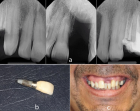Abstract
Research Article
4-year recurrence risk factors after tension-free vaginal tape-obturator as a treatment of stress urinary incontinence
De Miguel Manso S*, García García E, Gobernado Tejedor JA, Badillo Bercebal CE, Viruega Cuaresma D and González Martín JI
Published: 04 November, 2020 | Volume 3 - Issue 2 | Pages: 145-150
Objectives: Tension-free vaginal tapes are the gold standard of the surgical treatment of stress urinary incontinence (SUI); however, long-term recurrence of SUI after this surgery has been a matter of problem. Here, we attempted to determine the incidence of its recurrence and to identify the risk factors of 4-year-recurrence of SUI after this surgery.
Methods: Of all patients undergoing this surgery (n = 341, 2015-2019), 71 patients were met the study inclusion criteria. Of 71, SUI recurred in 8 patients, with the recurrence rate being 11.3%. The following three were identified to be independent risk factors: older age, history of delivery of macrosomic baby (>4 kg), and the presence of mixed urinary incontinence. The frequency of recurrence in cases with mixed incontinence amounted for 19.5%. Recurrence was 22 and 50% for women with macrosomic delivery once and more than twice, respectively.
Conclusion: Advanced age, macrosomic delivery and mixed urinary incontinence have shown to be independent risk factors of recurrence of SUI after tension-free vaginal tape-obturator at 4 years.
Key message: Stress urinary incontinence can recur so investigate possible risk factors is a priority. Our paper relates recurrence with: advanced age, fetal macrosomia and mixed incontinence.
Read Full Article HTML DOI: 10.29328/journal.cjog.1001069 Cite this Article Read Full Article PDF
Keywords:
Recurrence; Risk factors; Stress urinary incontinence
References
- Haylen BT, de Ridder D, Freeman RM, et al. International Urogynecological Association; International Continence Society. An International Urogynecological Association (IUGA)/International Continence Society (ICS) joint report on the terminology for female pelvic floor dysfunction. Neurourol Urodyn. 2010; 29: 5-26. PubMed: https://pubmed.ncbi.nlm.nih.gov/19937315/
- Capobianco G, Madonia M, Morelli S, Dessole F, De Vita D, et al. Management of female stress urinary incontinence: A care pathway and update. Maturitas. 2018; 109: 32-38. PubMed: https://pubmed.ncbi.nlm.nih.gov/29452779/
- Labrie J, Berghmans BL, Fischer K, Milani AL, van der Wijk I, et al. Surgery versus physiotherapy for stress urinary incontinence. Engl J Med. 2013; 369: 1124-1133. PubMed: https://pubmed.ncbi.nlm.nih.gov/24047061/
- European Association of Urology. EAU guidelines on urinary incontinence in adults. 2016 In: https://uroweb.org/wp-content/uploads/EAU-Guidelines-Urinary-Incontinence-2016.pdf
- Chapple CR, Cruz F, Deffieux X, Milani AL, Arlandis S, et al. Consensus Statement of the European Urology Association and the European Urogynaecological Association on the Use of Implanted Materials for Treating Pelvic Organ Prolapse and Stress Urinary Incontinence. Eur Urol. 2017; 72: 424-431. PubMed: https://pubmed.ncbi.nlm.nih.gov/28413126/
- Karmakar D, Mostafa A, Abdel-Fattah M. Long-term Outcomes of Transobturator Tapes in Women With Stress Urinary Incontinence: E-TOT Randomised Controlled Trial. BJOG. 2017; 124: 973-981. PubMed: https://pubmed.ncbi.nlm.nih.gov/28094468/
- Ford AA, Rogerson L, Cody JD, Aluko P, Ogah JA. Mid-urethral sling operations for stress urinary incontinence in women. Cochrane Database Syst Rev. 2017; 7: CD006375. PubMed: https://pubmed.ncbi.nlm.nih.gov/26130017/
- Barber MD, Kleeman S, Karram MM, et al. Risk factors associated with failure 1 year after retropubic or transobturator midurethral slings. Am J Obstet Gynecol. 2008; 199: 666.e1-7. PubMed: https://pubmed.ncbi.nlm.nih.gov/19084098/
- Angioli R, Plotti F, Muzii L, Montera R, Panici PB, et al. Tension-free Vaginal Tape Versus Transobturator Suburethral Tape: Five-Year Follow-Up Results of a Prospective, Randomised Trial. Eur Urol. 2010; 58: 671-677. PubMed: https://pubmed.ncbi.nlm.nih.gov/20709444/
- Stav K, Dwyer PL, Rosamilia A, Schierlitz L, Lim YN, et al. Risk Factors of Treatment Failure of Midurethral Sling Procedures for Women With Urinary Stress Incontinence. Int Urogynecol J. 2010; 21: 149-155. PubMed: https://pubmed.ncbi.nlm.nih.gov/19855914/
- Abdel-Fattah M, Ramsay I, Pringle S, et al. Evaluation of transobturator tension-free vaginal tapes in management of women with recurrent stress urinary incontinence. Urology. 2011; 77: 1070-1075. PubMed: https://pubmed.ncbi.nlm.nih.gov/21414653/
- Richter HE, Litman HJ, Lukacz ES, Sirls LT, Rickey L, et al. Urinary Incontinence Treatment Network. Demographic and clinical predictors of treatment failure one year after midurethral sling surgery. Obstet Gynecol. 2011; 117: 913-921. PubMed: https://pubmed.ncbi.nlm.nih.gov/21422865/
- Groutz A, Rosen G, Gold R, Lessing JB, Gordon D. Long-term outcome of transobturator tension-free vaginal tape: efficacy and risk factors for surgical failure. J Womens Health. 2011; 20: 1525-1528. Https://pubmed.ncbi.nlm.nih.gov/21819253/
- Serati M, Bauer R, Cornu JN, et al. TVT-O for the treatment of pure urodynamic stress incontinence: efficacy, adverse effects, and prognostic factors at 5-year follow-up. Eur Urol. 2013; 63: 872-878. PubMed: https://pubmed.ncbi.nlm.nih.gov/23274106/
- Yonguc T, Gunlusoy B, Degirmenci T, et al. Are the outcomes of transobturator tape procedure for female stress urinary incontinence durable in long-term follow-up? Int Urol Nephrol. 2014; 46: 1295-1300. PubMed: https://pubmed.ncbi.nlm.nih.gov/24384878/
- Betari R, Meynier J, Forzini T, François T, Hakami F, et al. Is Initial Success After Monarc(®) Suburethral Sling Durable at Mid-Term Evaluation? Prog Urol. 2016; 26: 409-414. PubMed: https://pubmed.ncbi.nlm.nih.gov/27032312/
- Jonsson Funk M, Siddiqui NY, Kawasaki A, Wu JM. Long-term Outcomes After Stress Urinary Incontinence Surgery. Obstet Gynecol. 2012; 120: 83-90. Https://pubmed.ncbi.nlm.nih.gov/22914395/
- Athanasiou S, Grigoriadis T, Zacharakis D, Skampardonis N, Lourantou D, et al. Seven Years of Objective and Subjective Outcomes of Transobturator (TVT-O) Vaginal Tape: Why Do Tapes Fail? Int Urogynecol J. 2014; 25: 219-225. PubMed: https://pubmed.ncbi.nlm.nih.gov/23892532/
- Costantini E, Kocjancic E, Lazzeri M, et al. Long-term Efficacy of the Trans-Obturator and Retropubic Mid-Urethral Slings for Stress Urinary Incontinence: Update From a Randomized Clinical Trial. World J Urol. 2016; 34: 585-593 PubMed:. Https://pubmed.ncbi.nlm.nih.gov/26231286/
- Serati M, Braga A, Athanasiou S, et al. Tension-free Vaginal Tape-Obturator for Treatment of Pure Urodynamic Stress Urinary Incontinence: Efficacy and Adverse Effects at 10-year Follow-up. Eur Urol. 2017; 71: 674-679. PubMed: https://pubmed.ncbi.nlm.nih.gov/27597239/
- Ashok K, Wang A. Recurrent Urinary Stress Incontinence: An Overview. J Obstet Gynaecol Res. 2010; 36: 467-473. PubMed: https://pubmed.ncbi.nlm.nih.gov/20598022/
- Perucchini D, delancey JOL, Ashton-Miller JA, Galecki A, Schaer GN. Age effects on urethral striated muscle. II. Anatomic location of muscle loss. Am J Obstet Gynecol. 2002; 186: 356-360. PubMed: https://pubmed.ncbi.nlm.nih.gov/11904591/
- Paick JS, Cho MC, Oh SJ, Kim SW, Ku JH. Factors influencing the outcome of mid urethral sling procedures for female urinary incontinence. J Urol. 2007; 178: 985-989. PubMed: https://pubmed.ncbi.nlm.nih.gov/17632151/
- Black NA, Downs SH. The effectiveness of surgery for stress incontinence in women: a systematic review. Br J Urol. 1996; 78: 497-510. PubMed: https://pubmed.ncbi.nlm.nih.gov/8944504
Figures:

Figure 1

Figure 2

Figure 3
Similar Articles
-
Screening of Gestational diabetes mellitusGehan Farid*,Sarah Rabie Ali*,Reem Mohammed Kamal. Screening of Gestational diabetes mellitus . . 2018 doi: 10.29328/journal.cjog.1001003; 1: 014-023
-
Giant cellular angiofibroma of the vulva: case reportAna Ribeiro*,Isabel Ferreira,Filomena Ramos. Giant cellular angiofibroma of the vulva: case report. . 2019 doi: 10.29328/journal.cjog.1001016; 2: 003-005
-
Maternal mortality and factors affecting it, among pregnant women in Abeokuta South, NigeriaTumilara Busayo Amoo*,Oyinkansola Sarah Ajayi. Maternal mortality and factors affecting it, among pregnant women in Abeokuta South, Nigeria. . 2019 doi: 10.29328/journal.cjog.1001025; 2: 071-078
-
Previous antibiotic treatment as a risk factor for recurrent vulvovaginal candidiasisWen Yang#,You Nie#,Shujuan Wang,Hongwei Wang,Enfeng Zhao,Na Dou*. Previous antibiotic treatment as a risk factor for recurrent vulvovaginal candidiasis. . 2019 doi: 10.29328/journal.cjog.1001034; 2: 127-132
-
Triple negative breast cancer: Early stages management and evolution, a two years experience at the department of breast cancer of CHSFBouzid Nassima,Darido Jessie*,Diari Jed,Dussour Chloe,Ezenfis Joel,Cahn Virginie,Guekeu Steven,Rigonnot Luc. Triple negative breast cancer: Early stages management and evolution, a two years experience at the department of breast cancer of CHSF. . 2020 doi: 10.29328/journal.cjog.1001052; 3: 065-078
-
Curettage is a risk factor for marginal umbilical cord insertionElie Nkwabong*,Simon Junior Mabol Mbeleck,Florence Tumasang. Curettage is a risk factor for marginal umbilical cord insertion. . 2020 doi: 10.29328/journal.cjog.1001054; 3: 081-084
-
4-year recurrence risk factors after tension-free vaginal tape-obturator as a treatment of stress urinary incontinenceDe Miguel Manso S*,García García E,Gobernado Tejedor JA,Badillo Bercebal CE,Viruega Cuaresma D,González Martín JI. 4-year recurrence risk factors after tension-free vaginal tape-obturator as a treatment of stress urinary incontinence. . 2020 doi: 10.29328/journal.cjog.1001069; 3: 145-150
-
Overview on current approach on recurrent miscarriage and threatened miscarriageBasant Sharma*,Jagat Deep,Chandrika Pandit,Bina Basnyat,Bandana Khanal,BB Raut,Brij Mohan Rajak,Deepak Patel,Rangina Laikangbam,Rajendra Basyal. Overview on current approach on recurrent miscarriage and threatened miscarriage. . 2020 doi: 10.29328/journal.cjog.1001070; 3: 151-157
-
Experience with trans radial uterine artery embolisation for uterine fibroids in a tertiary center in Saudi ArabiaGehan Farid*,Reem Kamal,Mohammed Thani Al-Shammari,Mohamed Swaraldahab,Hassan Swaraldahab. Experience with trans radial uterine artery embolisation for uterine fibroids in a tertiary center in Saudi Arabia. . 2020 doi: 10.29328/journal.cjog.1001072; 3: 167-174
-
Epidemiologic aspects and risk factors associated with infertility in women undergoing assisted reproductive technology (ART) in north of IranMarzieh Zamaniyan,Noushin Gordani*,Paniz Bagheri,Kaveh Jafari,Sepideh Peyvandi,Mojtaba Hajihoseini,Robabeh Taheripanah,Siavash Moradi,Salomeh Peyvandi,Arman Alborzi. Epidemiologic aspects and risk factors associated with infertility in women undergoing assisted reproductive technology (ART) in north of Iran. . 2021 doi: 10.29328/journal.cjog.1001079; 4: 015-018
Recently Viewed
-
Clinical and Histopathological Mismatch: A Case Report of Acral FibromyxomaMonica Mishra*,Kailas Mulsange,Gunvanti Rathod,Deepthi Konda. Clinical and Histopathological Mismatch: A Case Report of Acral Fibromyxoma. Arch Pathol Clin Res. 2025: doi: 10.29328/journal.apcr.1001045; 9: 005-007
-
Unconventional powder method is a useful technique to determine the latent fingerprint impressionsHarshita Niranjan,Shweta Rai,Kapil Raikwar,Chanchal Kamle,Rakesh Mia*. Unconventional powder method is a useful technique to determine the latent fingerprint impressions. J Forensic Sci Res. 2022: doi: 10.29328/journal.jfsr.1001035; 6: 045-048
-
Doppler Evaluation of Renal Vessels in Pediatric Patients with Relapse and Remission in Different Categories of Nephrotic SyndromeAmit Nandan Dhar Dwivedi*, Srishti Sharma, OP Mishra, Girish Singh. Doppler Evaluation of Renal Vessels in Pediatric Patients with Relapse and Remission in Different Categories of Nephrotic Syndrome. J Clini Nephrol. 2023: doi: 10.29328/journal.jcn.1001112; 7: 067-072
-
Atlantoaxial subluxation in the pediatric patient: Case series and literature reviewCatherine A Mazzola*,Catherine Christie,Isabel A Snee,Hamail Iqbal. Atlantoaxial subluxation in the pediatric patient: Case series and literature review. J Neurosci Neurol Disord. 2020: doi: 10.29328/journal.jnnd.1001037; 4: 069-074
-
Intelligent Design of Ecological Furniture in Risk Areas based on Artificial SimulationTorres del Salto Rommy Adelfa*, Bryan Alfonso Colorado Pástor*. Intelligent Design of Ecological Furniture in Risk Areas based on Artificial Simulation. Arch Surg Clin Res. 2024: doi: 10.29328/journal.ascr.1001083; 8: 062-068
Most Viewed
-
Evaluation of Biostimulants Based on Recovered Protein Hydrolysates from Animal By-products as Plant Growth EnhancersH Pérez-Aguilar*, M Lacruz-Asaro, F Arán-Ais. Evaluation of Biostimulants Based on Recovered Protein Hydrolysates from Animal By-products as Plant Growth Enhancers. J Plant Sci Phytopathol. 2023 doi: 10.29328/journal.jpsp.1001104; 7: 042-047
-
Sinonasal Myxoma Extending into the Orbit in a 4-Year Old: A Case PresentationJulian A Purrinos*, Ramzi Younis. Sinonasal Myxoma Extending into the Orbit in a 4-Year Old: A Case Presentation. Arch Case Rep. 2024 doi: 10.29328/journal.acr.1001099; 8: 075-077
-
Feasibility study of magnetic sensing for detecting single-neuron action potentialsDenis Tonini,Kai Wu,Renata Saha,Jian-Ping Wang*. Feasibility study of magnetic sensing for detecting single-neuron action potentials. Ann Biomed Sci Eng. 2022 doi: 10.29328/journal.abse.1001018; 6: 019-029
-
Pediatric Dysgerminoma: Unveiling a Rare Ovarian TumorFaten Limaiem*, Khalil Saffar, Ahmed Halouani. Pediatric Dysgerminoma: Unveiling a Rare Ovarian Tumor. Arch Case Rep. 2024 doi: 10.29328/journal.acr.1001087; 8: 010-013
-
Physical activity can change the physiological and psychological circumstances during COVID-19 pandemic: A narrative reviewKhashayar Maroufi*. Physical activity can change the physiological and psychological circumstances during COVID-19 pandemic: A narrative review. J Sports Med Ther. 2021 doi: 10.29328/journal.jsmt.1001051; 6: 001-007

HSPI: We're glad you're here. Please click "create a new Query" if you are a new visitor to our website and need further information from us.
If you are already a member of our network and need to keep track of any developments regarding a question you have already submitted, click "take me to my Query."

















































































































































